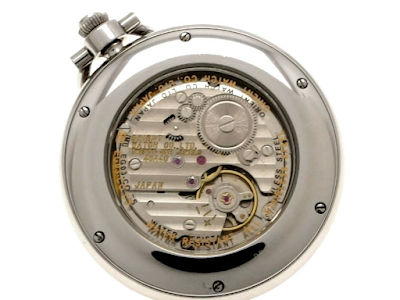Pocket
watches emerged in the early 16th century, when portable timekeeping was first
made possible by compact spring-driven mechanisms. Initially worn as pendants,
these early watches were both rare and ornate - more symbols of status than
reliable instruments. As craftsmanship improved, so did accuracy and design,
and by the 17th century, pocket watches had become flatter and rounder, allowing
them to slip more easily into waistcoat pockets - a style shift that coincided
with changes in men’s clothing, particularly the rise of the three-piece suit.
Through
the 18th and 19th centuries, pocket watches evolved into essential daily tools.
They were refined with complications, robust cases, and eventually standardized
movements that made them vital not just for gentlemen but for railway
conductors, military officers, and professionals across fields. This golden age
continued until the early 20th century, when wristwatches - initially a novelty
and often considered too delicate or feminine for men - gained prominence
during and after World War I, eventually replacing the pocket watch in everyday
use.
Today,
the pocket watch seems to be enjoying a quiet return, not as a utilitarian
object but as a fashion statement. On recent red carpets, particularly
high-profile events like the Met Gala, celebrities such as Jenna Ortega and
Leon Bridges were seen wearing pocket watches, in a pretty extravagant manner, and in great stylistic sync with one another.
A good excuse, then, to talk about Orient's pocket watches!
And
indeed, throughout the years, Orient has played with the concept of a pendant
or pocket watch a few times. Earliest examples were included with the Orient
Star Dynamic line, in the late 1950s.
Both
the round version and the triangular one (which was also discussed
before on the blog) were pretty uncommon releases at the time, and probably
produced in very small numbers. Hence, sample of these are near impossible to
find nowadays.
With
the brand's focus on wristwatches, it took years – in fact, decades – before considering
pocket-watch format again. Indeed I've seen some odd picture of an "AAA 21
Jewel" pocket watch but that looked so out of place I am almost certain it
was a re-casing of an old wristwatch. But the next familiar pocket-watch
releases I am confident with, were quartz models produced in the 1980s.
All
examples I saw of these items were gold-toned, and quite minimalist in design.
They seem to have been mainly aimed at female buyers, to be worn as pendants.
Again
it took some time before Orient returned to making a pocket watch. Around 2002
the brand released Orient Star Royal reference WZ0041EG, a truly fine piece in
the brand's highest standards of watchmaking at the time. Hand-wound caliber
48A40 ensured an accuracy of +10,-5 seconds per day and 50 hours of power
reserve.
A
few years had passed and Orient Star Royal became "Royal Orient".
Some of the older models were discontinued, but the pocket piece was among the
lucky few to get rebranded, and so – we got reference WE0041EG, essentially the
same watch but arguably carrying the nicer logo.
Note
that these models, despite being of a much higher quality (and price point)
than their quartz predecessors, were only produced in Stainless Steel – and I
feel the subtle elegance of these was indeed much better suited for the pocket
watch concept than the gold paint of the quartz.
Orient's
last batch of pocket watches was produced in the early 2010s. These weren't Royal
or Star but "regular" models, yet they were quite nicely designed and
made. These included WV0011DD and WV0031DD pictured above, and WV0021DD shown
below.
The
earlier references with Arabic numerals were introduced in 2010, and made use
of the then-new caliber 48C40, a downgraded version of the Royal 48A40, having
simpler decoration and reduced accuracy of +25/-15 seconds per day. The last
version, having the Roman numerals, was added in 2013. That was Orient's last
pocket watch, at least for now.
Photos
were taken from old Orient catalogs and sale ads, except the
"celebrities" photo taken from GQ magazine.










